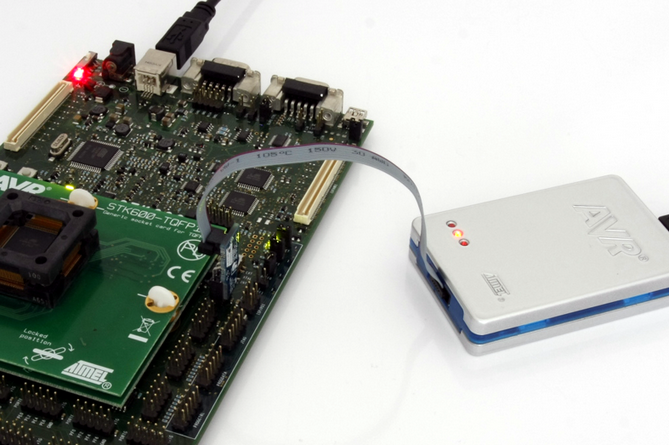3.5 Connecting to an SPI Target
The pinout for the 6-pin SPI connector is shown in Figure 4-8.
The adapters provided in the kit (A08-0735-B and A08-0735-C) can be used to connect to this pinout in either 50-mil or 100-mil options.
Be sure to use the correct orientation of the 6-pin header when connecting the Atmel JTAGICE3 to the target application PCB. A 'dot' on the adapter board indicates pin 1.
Note: The SPI interface is effectively disabled when the debugWIRE enable fuse (DWEN) is
programmed, even if SPIEN fuse is also programmed. To re-enable the SPI interface, the
'disable debugWIRE' command must be issued while in a debugWIRE debugging session.
Disabling debugWIRE in this manner requires that the SPIEN fuse is already programmed.
If Atmel Studio fails to disable debugWIRE, it is probable that the SPIEN fuse is NOT
programmed. If this is the case, it is necessary to use a high-voltage programming
interface to program the SPIEN fuse. It is HIGHLY ADVISED to simply let Atmel Studio
handle setting and clearing of the DWEN fuse!
The 10-pin mini-squid cable can also be used to connect between the Atmel JTAGICE3 target connector and the SPI target board. Six connections are required, as described in the table below.
| JTAGICE3 pins | Target pins | Mini-squid pin | SPI pinout |
|---|---|---|---|
| Pin 1 (TCK) | SCK | 1 | 3 |
| Pin 2 (GND) | GND | 2 | 6 |
| Pin 3 (TDO) | MISO | 3 | 1 |
| Pin 4 (VTG) | VTG | 4 | 2 |
| Pin 5 (TMS) | 5 | ||
| Pin 6 (nSRST) | /RESET | 6 | 5 |
| Pin 7 (Not connected) | 7 | ||
| Pin 8 (nTRST) | 8 | ||
| Pin 9 (TDI) | MOSI | 9 | 4 |
| Pin 10 (GND) | 0 |

